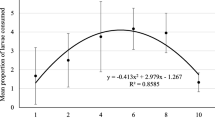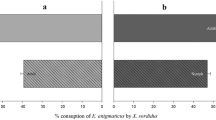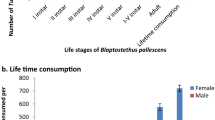Abstract
Abiotic factors, prey availability, prey type, and plant host actsimultaneously under field conditions. Their combined effects werepartially investigated for the predatory stinkbugPodisus nigrispinus(Dallas) (Heteroptera: Pentatomidae) preying on tomato leafminer (TLM)caterpillars Tuta absoluta (Meyrick)(Lepidoptera: Gelechiidae) (a preyfeeding on a plant host), and compared to yellow mealworm (YMW)Tenebrio molitor (Coleoptera: Tenebrionidae)pupae (a prey not feeding ona plant host). These experiments were carried out in the laboratory and inan open-sided greenhouse. In general, the environmental variationsbetween laboratory and open-sided greenhouse did not induce differencesin life history characteristics forP. nigrispinus feeding on the sameprey type. However, development and reproductionof P. nigrispinuswas greatly affected by prey type. Nymphal developmental times weresimilar between prey types under laboratory conditions; but were longer(and produced adults of lower body weight) when predators in theopen-sided greenhouse were fed on TLM compared with YMW. Mean mortalityduring the second instar was higher on both prey types in the open-sidedgreenhouse than in the laboratory. Adult emergencewas 38.5 and 50% inthe laboratory, and 32.5 and 48.6%in the open-sided greenhouse for bugsfed on TLM and YMW, respectively. Reproductive characteristics weresimilar for the different environmental conditions when the predator fed onthe same prey, but offspring production was greater for females fed on YMWcompared to females fed on TLM. These results suggest thatP. nigrispinus can adjust its performance accordingto the type of prey available, independently from environmentalvariations. It has the ability to survive on alternative prey,enabling it to maintain a presence in thetomato ecosystem until a primary pest species arrives.
Similar content being viewed by others
References
Aldrich, J.R., 1986. Seasonal variation of black pigment under the wings in a true bug (Hemiptera: Pentatomidae): A laboratory and field study. Proc. Mol. Wash. 88: 409–412.
Bozer, S.F., M.S. Traugott and N.E. Stamp, 1996. Combined effects of allelochemical-fed and scarce prey on the generalist insect predator Podisus maculiventris. Ecol. Entomol. 21: 328–334.
Cohen, A.C. and R. Tang, 1997. Relative prey weight influences handling time and biomass extraction in Sinea confusa and Zelus renardii (Heteroptera: Reduviidae). Environ. Entomol. 26: 559–565.
Coll, M., 1998. Feeding and living on plants in predatory Heteroptera. In: M. Coll and J.R. Ruberson (eds), Predatory Heteroptera: Their ecology and use in biological control. Entomological Society of America, Thomas Say Publications in Entomology, Lanham. pp. 89–129.
Crum, D.A., L.A. Weiser and N.E. Stamp, 1998. Effects of prey scarcity and plant material as a dietary supplement on an insect predator. Oikos 81: 549–557.
De Clercq, P., 2000. Predaceous stinkbugs (Pentatomidae: Asopinae). In: C.W. Schaefer and A.R. Panizzi (eds), Heteroptera of economic importance. CRC Press, Boca Raton. pp. 737–828.
De Clercq, P. and D. Degheele, 1990. Effects of temperature and relative humidity on the reproduction of the predatory bug Podisus sagitta (Fab.) (Heteroptera: Pentatomidae). Meded. Fac. Landbouw. Univ. Gent 55: 439–444.
De Clercq, P. and D. Degheele, 1992. Development and survival of Podisus maculiventris (Say) and Podisus sagitta (Fab.) (Heteroptera: Pentatomidae) at various constant temperatures. Can. Entomol. 124: 125–133.
De Clercq, P. and D. Degheele, 1997. Effects of mating status on body weight, oviposition, egg load, and predation in the predatory stinkbug Podisus maculiventris (Heteroptera: Pentatomidae). Ann. Entomol. Soc. Am. 90: 121–127.
Didonet, J., T.V. Zanuncio, J.C. Zanuncio and E.F. Vilela, 1996. Influência da temperatura na reprodução e na longevidade de Podisus nigrispinus (Dallas) e Supputius cincticeps (Stal) (Heteroptera: Pentatomidae). An. Soc. Entomol. Brasil 25: 117–123.
Evans, E.W., 1982. Consequences of body size for fecundity in the predatory stinkburg, Podisus maculiventris (Heteroptera: Pentatomidae). Ann. Entomol. Soc. Am. 75: 418–420.
Gomes, J.M., 1985. SAEG 3.0: Sistema de análises estatísticas e genéticas. Imprensa Universitária, Viçosa, MG, Brazil.
Hassell, M.P., 1985. Insect natural enemies as regulating factors. J. Anim. Ecol. 54: 323–334.
Legaspi, J.C., R.J. O'Neil and B.C. Legaspi, 1996. Trade-offs in body weights, egg loads, and fat reserves of field-collected Podisus maculiventris (Heteroptera: Pentatomidae). Environ. Entomol. 25: 155–164.
Legaspi, J.C. and B.C. Legaspi, 1998. Life history trade-offs in insects, with emphasis on Podisus maculiventris (Heteroptera: Pentatomidae). In: M. Coll and J.R. Ruberson (eds), Predatory Heteroptera: Their ecology and use in biological control. Entomological Society of America, Thomas Say Publications in Entomology, Laham. pp. 71–87.
Mills, N.J., 1982. Satiation and the functional response: A test of a new model. Ecol. Entomol. 7: 305–315.
Mohaghegh, J.N., P. De Clercq and D. Degheele, 1996. Influence of female body weight on reproduction in laboratory-reared Podisus nigrispinus and Podisus maculiventris (Heteroptera: Pentatomidae). Meded. Fac. Landbouw. Univ. Gent 61: 693–696.
Molina-Rugama, A.J., J.C. Zanuncio, D. Pratissoli and I. Cruz, 1998. Efeito do intervalo de alimentação na reprodução e na longevidade do predador Podisus nigrispinus (Dallas) (Heteroptera: Pentatomidae). An. Soc. Entomol. Brasil 27: 77–84.
O'Neil, R.J. and R.N. Wiedenmann, 1990. Body weight of Podisus maculiventris (Say) under various feeding regimes. Can. Entomol. 122: 285–294.
Pratissoli, D., 1995. Bioecologia de Trichogramma pretiosum Riley, 1879, nas traças Scrobipalpuloides absoluta (Meyrick, 1917) e Phtorimaea operculella (Zeller, 1873), em tomateiro. DS thesis. Esalq/USP, Piracicaba, Brazil.
Salas, S.J.M., 1996. Manejo integrado de Tuta absoluta (Meyrick, 1917) (Lepidoptera: Gelechiidae) através de inseticidas fisiológicos e Podisus nigrispinus (Dallas, 1851) (Hemiptera: Pentatomidae). DS Thesis. Esalq/USP, Piracicaba, Brazil.
Thomas, D.B., 1992. Taxonomic synopsis of the Asopinae Pentatomidae (Heteroptera) of the Western Hemisphere. Entomological Society of America, Thomas Say Publications in Entomology, Lanham.
Torres, J.B., J.C. Zanuncio and T.V. Zanuncio, 1996a. Produção e uso de percevejos predadores no controle biológico de pragas florestais. In: Anais do I Workshop sobre Proteção Florestal do Mercosul. UFSM-CEFET, Santa Maria, RS, Brazil. pp. 9–11.
Torres, J.B., J.C. Zanuncio, P.R. Cecon and W.L. Gasperazzo, 1996b. Mortalidade de Podisus nigrispinus (Dallas) por parasitóides de ovos em áreas de eucalipto. An. Soc. Entomol. Brasil 25: 463–471.
Torres, J.B., J.C. Zanuncio and M.C. Oliveira, 1997. Mating frequency and its effect on female reproductive output in the stinkbug predator Podisus nigrispinus (Heteroptera: Pentatomidae). Meded. Fac. Landbouw. Univ. Gent 62: 491–498.
Torres, J.B., J.C. Zanuncio and H.N. Oliveira, 1998. Nymphal development and adult reproduction of the stinkbug predator Podisus nigrispinus (Het., Pentatomidae) under fluctuating temperatures. J. Appl. Entomol. 122: 509–514.
Torres, J.B., P. De Clercq and R. Barros, 1999. Effect of spinosad on the predator Podisus nigrispinus and its lepidopterous prey. Meded. Fac. Landbouw. Univ. Gent 64: 211–218.
Torres, J.B. and J.C. Zanuncio, 2001. Effects of sequential mating by males on reproductive output of the stinkbug predator, Podisus nigrispinus. BioControl 46: 469–480.
Traugott, M.S. and N.E. Stamp, 1997. Effects of chlorogenic acid-and tomatine-fed caterpillars on performance of an insect predator. Oecologia 109: 265–272.
Vivan, L.M., J.B. Torres, A.F.S.L. Veiga and J.C. Zanuncio, 2002. Comportamento de predação e conversão alimentar de Podisus nigrispinus sobre a traça-do-tomateiro. Pesq. Agropec. Bras 37: 581–587.
Zanuncio, J.C., J.B. Torres, D.L. Bernardo and P. De Clercq, 1997. Effects of prey switching on nymphal development of four species of predatory stinkbug. Meded. Fac. Landbouw. Univ. Gent 62: 483–490.
Author information
Authors and Affiliations
Rights and permissions
About this article
Cite this article
Vivan, L.M., Torres, J.B. & Veiga, A.F. Development and reproduction of a predatory stinkbug, Podisus nigrispinus in relation to two different prey types and environmental conditions. BioControl 48, 155–168 (2003). https://doi.org/10.1023/A:1022642618219
Issue Date:
DOI: https://doi.org/10.1023/A:1022642618219




